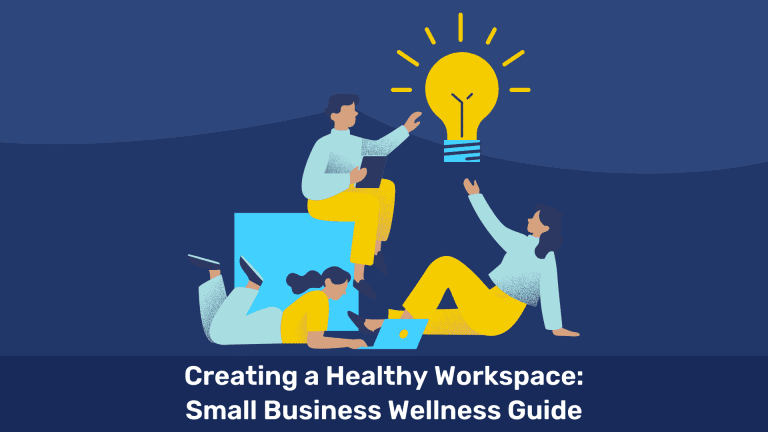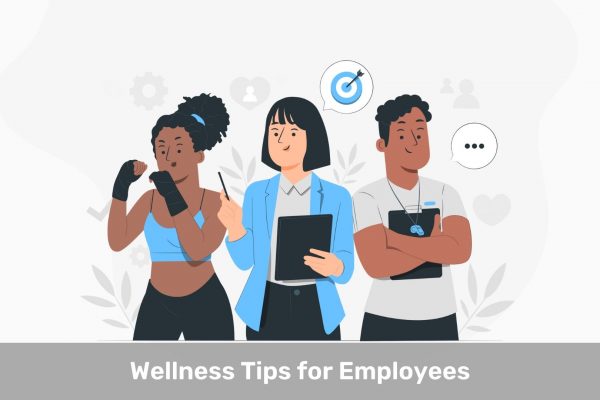Introduction
In the fast-paced and competitive world of small businesses, where innovation, growth, and success are the driving forces, the wellness of employees can often be overlooked. It’s easy for small business founders and teams to become consumed by the demands of building a business, often at the expense of their own physical and mental health. However, this approach is unsustainable in the long run and can lead to burnout, decreased productivity, and high turnover rates.
Picture the iconic image of a bustling startup office: walls adorned with inspirational quotes, teams huddled around whiteboards discussing Small Business Wellness strategies, and the hum of creativity in the air. Yet, amidst the whirlwind of innovation, an often-neglected aspect emerges—the well-being of the very individuals driving these groundbreaking ideas.
Small Business Wellness are more liable to shape a favorable and enduring workplace, culminating in heightened employee contentment, elevated levels of involvement, and ultimately, enhanced business consequences.
In this article, we’ll explore the critical aspects of prioritizing wellness in small businesses and provide a comprehensive guide to help small businesses create a healthy work environment that fosters employee well-being, focusing on Small Business Wellness, and organizational success.
The Small Business Wellness Imperative
Small businesses that place a primary emphasis on wellness right from the start lay the foundation for a more robust and prosperous future. The significance of a sound work environment goes beyond mere positivity; it has a direct impact on the financial outcomes. Studies have demonstrated that small businesses concentrating intently on wellness encounter heightened efficiency, diminished absenteeism, and decreased turnover rates.
By giving precedence to wellness, small businesses can foster a milieu in which team members feel esteemed, bolstered, and driven to contribute their utmost. Within the framework of a small business, where the contributions of every team member hold immense value, ensuring their well-being can pave the way for heightened ingenuity, sound decision-making, and enhanced teamwork.
Understanding Small Business Wellness
1. Acknowledge the Lifestyle:
Small Businesses often require a higher level of commitment and dedication from their employees, which can lead to long working hours, high stress levels, and a constant pressure to achieve ambitious goals. Acknowledging these unique challenges is the first step in understanding the importance of small businesses wellness.
2. Holistic Approach:
Wellness extends beyond physical health. It encompasses mental, emotional, nutrition, lifestyle,and social well-being. While physical health is undoubtedly important, addressing employees’ mental and emotional needs is equally crucial, especially given the high-pressure environment of small businesses
3. Impact on Creativity and Innovation:
A well-nurtured, healthy employee is more likely to be creative and innovative. When employees feel physically and mentally well, they’re better equipped to approach challenges with fresh perspectives, generate novel ideas, and contribute to the small business’s success.
Elements of a Healthy Work Environment
1. Physical Environment:
Creating a physical environment that prioritizes the well-being of small businesses employees goes beyond aesthetics – it directly impacts their health, comfort, and productivity. By focusing on ergonomic design and incorporating opportunities for movement, small businesses can significantly enhance the physical well-being of their team members. In this section, we’ll explore the importance of ergonomic considerations and introduce exercises that can be performed while sitting in a chair, promoting both comfort and activity within the workspace.
Ergonomics: The Foundation of Comfort
Ergonomics is the science of designing workspaces, tools, and equipment to fit the needs of individuals, thereby optimizing their well-being and productivity. In a small businesses setting, where employees may spend long hours at their desks, investing in ergonomic solutions can make a substantial difference.
-
-
- Ergonomic Chairs: Provide ergonomic chairs that offer proper lumbar support, adjustable armrests, and seat height. These chairs encourage healthy posture and reduce the risk of discomfort or musculoskeletal issues.
- Standing Desks: Consider offering standing desks that allow employees to alternate between sitting and standing throughout the day. This variation can improve circulation and reduce the strain on the lower back.
- Adjustable Workstations: Equip workstations with adjustable monitors, keyboards, and mice to accommodate individual preferences and promote comfortable positioning.
-
In-chair Exercises: Active Breaks for Desk-bound Days
Long hours of sitting can lead to stiffness and decreased circulation. Introducing simple in-chair exercises can help employees stay active and alleviate discomfort without interrupting their workflow.
-
-
- Seated Leg Lifts: While seated, extend one leg outward, hold for a few seconds, and then lower it. Alternate between legs to engage the quadriceps and improve blood flow.
- Ankle Circles: Lift your feet slightly off the ground and rotate your ankles in clockwise and counterclockwise circles. This exercise helps improve ankle flexibility and prevents stiffness.
- Seated Torso Twists: Sit up straight and gently twist your upper body to one side, using the armrest for support. Hold for a few seconds, then repeat on the other side to stretch the spine and oblique muscles.
- Shoulder Rolls: Roll your shoulders forward and backward in a circular motion. This exercise helps relieve tension in the shoulders and upper back.
- Seated Marching: Lift one knee toward your chest while seated, then alternate with the other knee. This movement engages the core muscles and stimulates circulation.
- Desk Push-ups: Place your hands on the edge of your desk, shoulder-width apart. Lower your body towards the desk and then push back up. This exercise engages the upper body muscles.
- Neck Stretches: Gently tilt your head to one side, bringing your ear towards your shoulder. Hold for a few seconds and repeat on the other side. This exercise helps release tension in the neck muscles.
-
Encouraging Movement and Activity
-
-
- Active Breaks: Encourage employees to take short active breaks throughout the day. Set reminders for them to stand, stretch, or perform in-chair exercises to prevent prolonged sitting.
- Walking Meetings: Whenever feasible, conduct walking meetings, either indoors or outdoors. Walking while discussing ideas not only promotes movement but also fosters creative thinking.
- Stair Use: If your office has stairs, encourage employees to use them instead of the elevator. Climbing stairs is a great way to increase heart rate and engage leg muscles.
-
2. Mental and Emotional Well-being:
In the fast-paced world of Small businesses, where constant innovation and high-stakes decision-making are the norm, mental and emotional well-being can often take a back seat. However, creating a work environment that prioritizes the mental and emotional health of employees is not only a moral imperative but also a strategic advantage. A team that is mentally and emotionally resilient is better equipped to navigate challenges, drive innovation, and contribute to the overall success of the small businesses. In this section, we will explore strategies for promoting mental and emotional well-being in small businesses, with a focus on stress management, work-life balance, open communication, and the power of gamification.
Stress Management: Cultivating Inner Calm
Small Businesses are no strangers to high-pressure situations, tight deadlines, and constant change. To support employees in navigating these stressors, it’s essential to offer stress management resources that empower them to cultivate inner calm and resilience.
-
-
- Mindfulness Sessions: Introduce mindfulness practices such as guided meditation sessions or mindfulness workshops. These sessions provide employees with practical tools to manage stress, enhance focus, and promote emotional regulation.
- Meditation Classes: Regular meditation classes can offer employees a designated time to disconnect from work-related stress and connect with their inner selves. Meditation has been shown to reduce anxiety and improve overall well-being.
- Professional Counseling Services: Collaborate with mental health professionals to provide confidential counseling services. Offering access to trained therapists allows employees to seek support when facing challenges or experiencing heightened stress.
-
Work-Life Balance: Striking the Equilibrium
Striking a healthy work-life balance is crucial for maintaining mental and emotional well-being. Small businesses culture often celebrates dedication and hard work, but it’s important to emphasize that well-rested and rejuvenated employees are more productive and innovative.
-
-
- Clear Expectations: Set clear expectations regarding working hours and communicate that the small businesses values quality output over the number of hours worked. Encourage employees to complete their tasks efficiently rather than simply clocking in long hours.
- Flexible Scheduling: Provide flexible work hours or remote work options, allowing employees to tailor their schedules to their individual needs. This flexibility enables them to manage personal responsibilities while maintaining their professional commitments.
- Unplugged Time: Encourage designated “unplugged” time, where employees are encouraged to disconnect from work-related emails and messages outside of their working hours. This practice ensures that employees have dedicated time for personal activities and relaxation.
-
Open Communication: Breaking Down Barriers
Creating a safe space for open communication about mental and emotional well-being is pivotal in normalizing discussions around these topics. A culture that encourages dialogue helps reduce stigma and empowers employees to seek support when needed.
-
-
- Mental Health Awareness Campaigns: Launch awareness campaigns that provide information about mental health, its importance, and available resources. These campaigns can include workshops, seminars, and informative materials distributed to employees.
- Supportive Leadership: Leaders play a crucial role in setting the tone for open communication. When leaders openly discuss their own experiences with stress or mental health challenges, it encourages employees to feel comfortable sharing their concerns.
- Employee Resource Groups: Establish employee resource groups focused on mental health. These groups create a community where employees can share their experiences, offer support, and collaborate on initiatives that promote well-being.
-
The Power of Gamification: Engaging in Mental Wellness Initiatives
Gamification is a creative and effective approach to engaging employees in mental wellness initiatives. By transforming small business wellness activities into interactive and rewarding experiences, small businesses can enhance employee participation and motivation.
-
-
- Gamified Articles: Create articles that incorporate interactive elements, such as quizzes, polls, and challenges. These articles can educate employees about stress management techniques, resilience-building strategies, and the importance of work-life balance.
- Wellness Challenges: Design wellness challenges that employees can participate in individually or as teams. These challenges could involve practicing mindfulness, taking regular breaks, or engaging in physical activities, with points or rewards for completing tasks.
- Progress Tracking: Implement a platform where employees can track their progress in wellness initiatives and earn badges or rewards for achieving milestones. This approach adds an element of competition and achievement, encouraging ongoing engagement.
-
3. Collaboration and Community:
The success of a small business hinges on the collective efforts of its team members, and cultivating an environment that promotes collaboration and a sense of belonging can significantly impact productivity, innovation, and overall organizational success. In this section, we’ll explore strategies for enhancing collaboration and building a thriving community within small businesses, including team-building activities, shared goals, and the power of creating an inclusive culture. Moreover, we’ll delve into the concept of team activity challenges powered by modern solutions that bring the entire workforce together.
Team Building: Strengthening Bonds
Collaboration is most effective when team members share strong relationships and open lines of communication. Team-building activities play a pivotal role in creating these connections and fostering a sense of camaraderie among employees.
-
-
- Regular Activities: Organize regular team-building events, whether they’re in-person gatherings, virtual sessions, or a combination of both. Activities can range from problem-solving challenges to recreational outings, allowing employees to interact in a relaxed environment.
- Cross-Functional Teams: Form cross-functional teams for specific projects or activities. This practice encourages employees from different departments to collaborate, exchange ideas, and leverage their diverse skills and perspectives.
- Icebreakers: Incorporate icebreaker activities during team meetings or training sessions. Icebreakers can help break down barriers, encourage conversation, and enhance team members’ comfort levels with one another.
-
Shared Goals: Aligning for Impact
Effective collaboration requires a shared sense of purpose and alignment toward common goals. When employees understand how their individual contributions contribute to the larger organizational mission, their motivation and engagement increase.
-
-
- Mission and Vision: Clearly communicate the small business’s mission and vision to all employees. Explain how each team member’s work contributes to the overall success of the small business and its impact on the industry or community.
- Regular Updates: Provide regular updates on the progress and milestones achieved as a result of collaborative efforts. Sharing success stories and recognizing individual contributions reinforces the idea that teamwork drives results.
- Cross-Functional Initiatives: Launch initiatives that require collaboration across different teams or departments. When employees work together on projects that span their expertise areas, they gain a broader understanding of the small business’s operations.
-
Inclusive Culture: A Foundation for Collaboration
An inclusive culture is essential for creating a supportive and collaborative work environment. When employees feel valued, respected, and included, they are more likely to share ideas, collaborate openly, and contribute their unique perspectives.
-
-
- Diversity and Inclusion Initiatives: Implement diversity and inclusion programs that promote fairness, equity, and representation across the organization. These initiatives can include workshops, training, and mentorship opportunities.
- Open Door Policy: Encourage an open door policy where employees feel comfortable sharing their thoughts, concerns, and suggestions with leaders. This practice promotes a culture of transparency and collaboration.
- Employee Resource Groups: Establish employee resource groups that focus on specific aspects of diversity, such as gender, ethnicity, or interests. These groups provide spaces for employees to connect and collaborate on initiatives that matter to them.
-
Team Activity Challenges: Uniting the Workforce
The modern workforce is often distributed across various locations, making it challenging to build a cohesive community. Leveraging technology and interactive solutions can bridge this gap and promote collaboration through team activity challenges.
-
-
- Virtual Challenges: Utilize specialized apps and platforms to organize virtual team activity challenges. These challenges could involve solving puzzles, completing tasks, or participating in virtual scavenger hunts, fostering engagement and teamwork.
- Leaderboards and Rewards: Create leaderboards to track teams’ progress in challenges. Offer rewards or recognition for top-performing teams, motivating healthy competition and teamwork.
- Real-time Collaboration: Incorporate real-time collaboration features in virtual challenges, allowing team members to communicate and strategize as they work together to complete tasks.
-
4. Flexibility:
- Remote Work: Offer remote work options to accommodate employees’ needs and preferences. Remote work can enhance work-life balance and reduce commute-related stress.
- Flexible Hours: Allow employees to have flexible work hours, enabling them to adapt their schedules to their peak productivity times and personal commitments.
5. Nutrition: Fueling Performance and Vitality
The role of nutrition in a healthy work environment cannot be understated. Providing access to nourishing food options and promoting mindful eating can significantly impact employee energy levels, cognitive function, and overall health.
-
- Healthy Food Choices: Stock the office kitchen or cafeteria with a variety of nutritious snacks and beverages. Offer options such as fresh fruits, vegetables, whole grains, lean proteins, and unsweetened beverages.
- Nutrition Education: Organize workshops or seminars on nutrition, helping employees understand the importance of balanced eating and making informed food choices.
- Mindful Eating: Encourage employees to practice mindful eating, which involves being fully present while consuming meals and snacks. Mindful eating can help prevent overeating and promote a healthier relationship with food.
- Hydration: Provide access to clean and filtered water throughout the workspace. Proper hydration is essential for maintaining energy levels, focus, and overall well-being.
- Healthy Eating Challenges: Launch fun and engaging challenges that encourage employees to make healthier food choices. For example, you could organize a “Healthy Lunch Challenge” where employees share their nutritious meal idea
Implementing Small Businesses Wellness Initiatives
1. Leadership Buy-In:
-
- Lead by Example: small business leaders should actively participate in wellness initiatives and demonstrate their commitment to employee well-being. When leaders prioritize their own health, it sets a positive example for the entire team.
- Allocate Resources: Allocate a dedicated budget and allocate personnel to drive wellness programs and initiatives. Clearly communicate that employee wellness is a priority for the organization.
2. Tailor to Small Business Culture:
-
- Personalization: Recognize that every small business has its unique culture and dynamics. Tailor small business wellness initiatives to align with your small business’s values and the preferences of your employees.
- Innovation: Infuse creativity into wellness programs to reflect the innovative spirit of your startup. Consider unique and engaging ways to promote wellness that resonate with your team.
3. Employee Involvement:
-
- Feedback: Regularly seek feedback from employees to understand their wellness needs, preferences, and pain points. Employee input is invaluable in shaping effective wellness programs.
- Wellness Committees: Establish wellness committees comprising representatives from different teams. These committees can brainstorm, plan, and implement wellness initiatives that cater to various interests and needs.
Measuring Small Business Wellness Success
Creating a culture of small business wellness goes beyond mere implementation; it involves continuous evaluation and measurement to gauge the effectiveness of these initiatives. By employing a combination of quantitative and qualitative metrics, small businesses can gain valuable insights into the impact of their wellness programs on employee well-being, satisfaction, and overall organizational success. In this section, we’ll explore various metrics for measuring wellness success, including the use of comprehensive assessments, biometric screening data, and analytics dashboards. We’ll also discuss the advantages of adopting a holistic wellness solution like Woliba.
Quantitative Metrics: Tangible Indicators of Progress
-
-
- Productivity Metrics: Track changes in productivity by monitoring task completion rates, project milestones achieved, and overall output. Compare these metrics before and after implementing wellness initiatives to identify improvements in employee efficiency and effectiveness.
- Absenteeism Rates: Keep a close watch on absenteeism and sick days. A decrease in absenteeism can indicate that wellness efforts are positively impacting employee health and overall well-being.
-
Qualitative Metrics: Employee Perception and Satisfaction
-
-
- Employee Satisfaction Surveys: Conduct regular surveys or feedback sessions to gather insights into employee satisfaction with wellness programs and the work environment. Assess how well these initiatives are meeting employee needs and expectations.
- Feedback and Testimonials: Collect personal stories and testimonials from employees who have participated in wellness initiatives. These narratives provide firsthand accounts of the positive impact on individual well-being and can serve as motivational anecdotes for others.
-
Comprehensive Health Assessments and Biometric Screening:
Health Risk Assessments (HRAs): Conduct comprehensive HRAs to gain a comprehensive understanding of employees’ health status, lifestyle behaviors, and risk factors. This data can serve as a baseline for tracking improvements over time.
Biometric Screening Data: Collect data from biometric screenings, such as blood pressure, cholesterol levels, and body mass index (BMI), to assess employees’ physical health and identify areas for improvement.
Analytics Dashboard: Visualizing Progress and Insights
Implement a detailed analytics dashboard that integrates data from various sources, enabling small businesses to visualize trends, correlations, and improvements. The dashboard should compare data from the period before implementing wellness initiatives with data from subsequent months or years.
Tracking Wellness Pillars: The analytics dashboard should cover multiple dimensions of wellness, including physical, mental, emotional, and social well-being. This comprehensive approach ensures a well-rounded assessment of wellness program effectiveness.
Customizable Metrics: The dashboard should allow customization based on the specific wellness initiatives and goals of the small business. It should be able to track key performance indicators related to engagement, participation rates, and outcome improvements.
Adopting a Holistic Wellness Solution
In the dynamic realm of small businesses, fostering employee well-being is pivotal, yet traditional wellness approaches can fall short in tracking and optimizing comprehensive wellness initiatives. To overcome this, small businesses are turning to holistic wellness solutions,like Woliba combining personalized wellness plans, robust analytics, and engagement features to ensure well-being across all dimensions.
Challenges of Traditional Approaches: Conventional wellness programs often struggle to measure and enhance well-being holistically, hampering data collection and impact assessment.
Key Elements of a Holistic Wellness Solution:
-
-
- Personalized Plans: Tailoring wellness strategies to individual needs, goals, and preferences.
- Comprehensive Data: Collecting data from HRAs, biometrics, and lifestyle assessments for a comprehensive view.
- Detailed Analytics: Real-time insights through an analytics dashboard, tracking trends and outcomes.
- Custom Metrics: Adapting metrics to align with specific wellness targets.
- Engagement Tools: Utilizing challenges, social interactions, and rewards to boost participation.
-
Streamlined Wellness Management: By embracing a holistic wellness solution, small businesses simplify management, empowering impactful wellness initiatives.
Conclusion
In the realm of small business wellness, acknowledging that the well-being of employees is not just a sentimental notion, but a strategic imperative, takes on paramount importance. It becomes a vital driver for long-term sustainability. By taking proactive steps to address physical, mental, nutritional, and emotional well-being, small businesses cultivate an atmosphere conducive to thriving collaboration, embracing flexibility, and promoting a holistic way of life.
Harnessing cutting-edge technological solutions such as Woliba further enhances these wellness endeavors. The integration of Comprehensive Health Risk Assessments (HRAs), tailored wellness blueprints, and data-driven analytical dashboards empowers small businesses to effectively gauge and augment their well-being strategies. This tech-infused approach perfectly resonates with the innovative ethos of small businesses, ensuring that well-being harmonizes with their pioneering spirit.
A dynamic work environment within small businesses doesn’t merely spur creativity; it propels productivity, reinforces employee retention, and lays the cornerstone for enduring expansion. As small businesses reshape various industries, the wellness paradigm becomes their guiding star. With technology as the propelling catalyst, well-being transforms into a shared odyssey where employees flourish, small businesses thrive, and innovation propels both toward sustained accomplishments.






